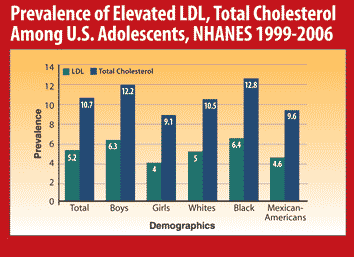Less than 1% of U.S. adolescents eligible for LDL-lowering treatment
Approximately 0.8% of adolescents aged 12 to 17 years were potentially eligible to receive pharmacological treatment for elevated LDL concentrations, according to results of a study based on current guidelines.
Using the National Health and Nutrition Examination Survey 1999 to 2006 data, CDC researchers estimated distributions in total cholesterol, LDL and the prevalence of participants eligible for lipid-lowering treatment.
Participants aged 6 to 17 years had a mean concentration of total cholesterol of 163 mg/dL (n=9,868) and adolescents aged 12 to 17 years had a mean LDL concentration of 90.2 mg/dL (n=2,724).
Certain demographic variables were predictors of cholesterol concentrations. Total cholesterol was 3.6 mg/dL higher among girls when compared with boys and 6.2 mg/dL lower among adolescents aged 12 to 17 years compared with younger participants aged 6 to 11 years (P<.001 for both). Total cholesterol concentrations were also 2.6 mg/dL higher among black participants compared with whites (P=.006) and 1.9 mg/dL lower among Mexican-Americans compared with whites (P=.022).
Elevated LDL was present in 5.2% to 6.6% of adolescents and elevated total cholesterol in 9.6% to 10.7%, depending on cut points used. Eleven of the 26 adolescents (0.8%) aged 12 to 17 years who qualified for pharmacological treatment had an LDL concentration >190 mg/dL. Also, 15 had at least one risk factor and a concentration >160 mg/dL.
The researchers conducted this study in response to new guidance by the American Academy of Pediatrics in July 2008 that recommended LDL-lowering pharmacological treatment for children. – by Katie Kalvaitis
Circulation. 2009;119:1108-1115.


![]()
Unlike the case with current guidelines for treatment of adults, the question of whether or not to commit children and adolescents to lipid-lowering therapy is based on prevention of premature onset accelerated atherosclerosis rather than prevention of short-term cardiovascular events. By intervening early, it is likely that the long-term or lifetime morbidity and excess mortality of atherosclerosis can be reduced or avoided. It is not surprising that only a small minority of children in the NHANES cohort qualified for lipid-lowering therapy under the AAP guidelines. A substantial proportion of the 26 children qualifying for treatment (n=11) with serum LDL >190 mg/dL were likely those with either familial hypercholesterolemia or another genetically mediated abnormality of LDL metabolism. The remaining 15 children met criteria for treatment with at least one risk factor and LDL >160 mg/dL. Need for treatment did not differ by race, age or ethnicity.
These findings must be viewed cautiously as they only speak to a very limited extent of the problem at hand. The point is clear that children with very high LDL have a genetically mediated dyslipidemia and most would agree warranting drug therapy starting early in life. It behooves us as clinicians to identify these high-risk individuals, to correctly diagnose their underlying dyslipidemia, to identify other family members sharing the high-risk phenotype and to treat. The remainder qualifying for treatment in the NHANES survey did so on the basis of concurrent risk factors at lower LDL cut points, reemphasizing our need to identify and treat risk factors throughout life starting in childhood as our primary intervention to limit lifetime atherosclerosis risk.
Without successfully intervening to control the continued high prevalence of smoking and rising prevalence of obesity, very early onset metabolic syndrome and diabetes, we will surely fail to control its long-term atherosclerosis-related complications. The atherogenic Westernized diets must evolve to more Mediterranean-like patterns having proven efficacy in reducing atherogenic potential independent of lipid effects, as was shown decades ago in the Seven Countries Study (JAMA. 1995;274:131-136 and Eur J Epidemiol. 1999;15:507-515) and confirmed in more recent studies, such as EPIC (N Engl J Med. 2003;348:2599-2608). The results of the Atherosclerosis Risk Factors in Male Youngsters study (Circulation. 2003;108:1064-1069) showed evidence of accelerated atherosclerosis as assessed by carotid intima-media thickness to be correlated with smoking, heightened immune reactivity, diastolic blood pressure and low HDL in adolescents aged 17 to 18 years. A similar study — Atherosclerosis Risk Factors in Female Youngsters — was conducted to study women aged 18 to 22 years showing association of environmental tobacco smoke exposure, traffic exhaust, autoimmune processes and high lipoprotein(a) to increase carotid intima-media thickness (Stroke. 2009;doi:10.1161/STROKEAHA.108.525675). A small subset will require drug therapy and will carry identifiable lipid-mediated risk. However, the opportunity to intervene in the broader population attributable risk will primarily reside in management of dietary, behavioral and nonlipid risk factors. Collectively, all these studies’ results should further strengthen our resolve to identify and manage the spectrum of risk factors known to contribute to premature atherosclerosis in children, adolescents and young adults.
– Steven R. Jones, MD
Assistant Professor of Medicine,
Director of Inpatient
Cardiology, Johns Hopkins Heart and Vascular Institute
